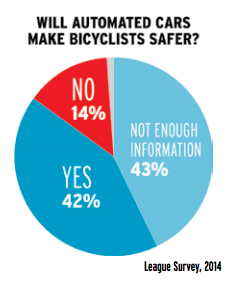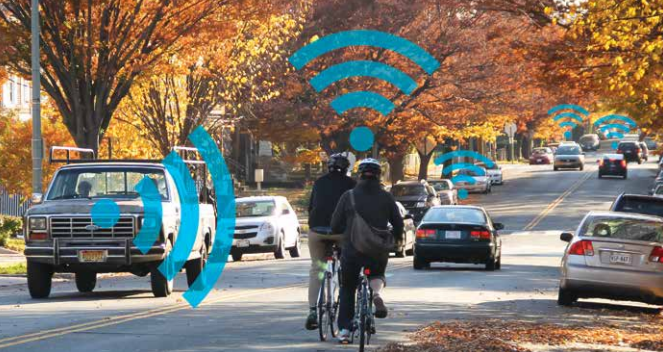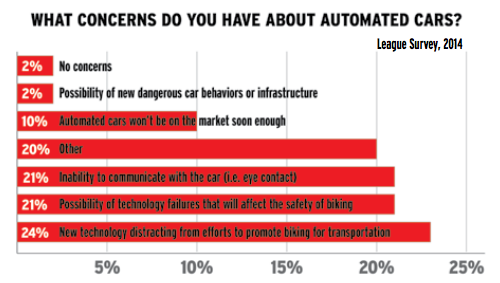DISCOVER YOUR LOCAL BICYCLING COMMUNITY
Find local advocacy groups, bike shops, instructors, clubs, classes and more!
Will automated cars make bicyclists safer?
 Connected and automated vehicles are two distinct technologies that have the potential to revolutionize automotive travel and road safety for everyone — and they’re likely to enter our roadways in just a few years.
Connected and automated vehicles are two distinct technologies that have the potential to revolutionize automotive travel and road safety for everyone — and they’re likely to enter our roadways in just a few years.
Connected vehicles can “talk” to each other, exchanging information like speed, brake force and direction. Automated vehicles control driving functions, either relieving a driver of a function or augmenting a driver’s ability.
These vehicles are no longer the realm of science fiction; they are the future. And they have the potential to create an entirely new relationship between people, cars, and transportation. Connected vehicles enable technological solutions to mitigate distracted driving and augment the senses of drivers.
Google, for instance, has been at the forefront of showing how bicyclists and autonomous vehicles might interact, and released a cute and comforting self-driving prototype in 2014. According to several predictions, autonomous vehicles may reduce crashes by up to 90% because most crashes involve human error. If true, we can anticipate crashes between bicyclists and autonomous vehicles will be rare and hopefully less severe when they do occur.
But there’s reason to be skeptical of the safety benefits for bicyclists and pedestrians. Some analysis suggests that autonomous vehicles will be no safer than an average driver and may be less safe in mixed traffic. Autonomous and connected vehicles may also introduce new risks, such as system failures, cyberterrorism, more risky behavior by drivers who feel safer, and increased vehicle travel.
Safety benefits for non-occupants, like bicyclists and pedestrians, also depend on vehicle systems and any associated infrastructure being designed with nonmotorists in mind. Car companies tend to worry about the people who buy their cars — for instance, Volvo currently has a goal of no deaths in its new cars by 2020 — but don’t have a goal to reduce deaths caused by their new cars. As advocates, it will be important to ensure that non-motorists are included in the development and implementation of these technologies, rather than as an afterthought.

TWO POTENTIAL VISIONS FOR THE FUTURE
Looking into the future of sharing the road with connected and autonomous vehicles, a lot depends on how these technologies and vehicles are adopted and implemented. In the first adoption scenario, there’s the potential for a dramatic shift in society’s relationship with cars.
Mobility solution providers, like Uber, Car2Go, and Zipcar, might invest in providing autonomous fleets and these on-demand vehicles would replace private vehicle ownership for many individuals in urban and suburban areas. According to some predictions, this might result in up to a 99% reduction in the number of vehicles on roads and radically change the automotive industry. It’s not clear how this societal shift might impact the relationship between bicycles and vehicles, and the organized interests of these mobility companies rather than automotive companies.
But the urban orientation of these companies suggests a better relationship. In the second adoption scenario, autonomous technology might mirror past technology adoptions, like air bags, and take 40 or more years to make a significant impact. In this scenario, it might be more likely that autonomous vehicles are marketed based on their ability to make long commutes more enjoyable and productive.
A recent marketing video for the Mercedes F 015 concept car primarily shows rural driving and socializing while being driven. This adoption scenario might be more likely to exacerbate some land use and infrastructure issues that make it difficult to reach places by biking and walking and lead to autonomous technology being initially designed for places without humans, making benefits for non-motorists a secondary concern.

THE CHANGING LANDSCAPE
Currently, the National Highway Traffic Safety Administration is adopting rules for how connected vehicle technology will be implemented, including a potential mandate for the technology in new vehicles. A final rule is expected by 2017.
In the meantime, several states have adopted laws allowing autonomous vehicles to operate on their roads. Several, including California, are now adopting regulations for autonomous vehicles and their drivers are looking towards more widespread use. And autonomous vehicles are beginning to be considered in Long-Range Transportation Plans of Metropolitan Planning Organization and by state Departments of Transportation considering their long-term transportation investments.
So what kind of impacts should we be watching — and watchdogging? Autonomous vehicles might contribute to sprawl if they make longer commutes more palatable and less costly and contribute to increased vehicle miles traveled for a variety of reasons, including the use of private vehicles for unchained errand trips. These new cars could enable new road designs — perhaps making more space available to bicyclists and pedestrians through reduce parking demand or narrower travel lanes — and could alter the types of infrastructure investment.
When it comes to safety, automated cares might reduce risks for people who can afford them, but may not make roads safer for those who cannot afford them and may even disrupt transit investments and services. Perhaps most promising, though: These new technologies could dramatically change the experiences of people “driving” and might relieve the frustration many drivers feel in their interactions with bicyclists and pedestrians.
GET BEHIND THE WHEEL
What will the future look like? Check out the BikeShield app, which allows drivers to get an audible signal warning them of an approaching bicycle.